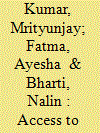|
|
|
Sort Order |
|
|
|
Items / Page
|
|
|
|
|
|
|
| Srl | Item |
| 1 |
ID:
183856


|
|
|
|
|
| Summary/Abstract |
Affordable access to medicines is a key determinant of a country’s resilience to health crises. The modern hyper-connected international trade and production networks have a vital role to play in ensuring this accessibility, especially in the context of a pandemic. This article focuses on medicines and medical equipment and analyses the synergistic role of the two international organisations—The World Trade Organisation (WTO) and The World Health Organisation (WHO), in assuring affordable access to these goods globally. WHO is responsible for global healthcare regulations; however, the medical supply chain originates in a few developed countries, manufactured in bulk (in case of medicine) at low cost in developing countries, and finally traded worldwide. Here, the role of WTO comes in where it facilitates global trade cooperation and intellectual property rights monitoring, both key elements in medical goods production and trading. Despite the need for cooperation in mitigating COVID-19, much of the global response to COVID-19 has been fragmented and inward-looking. This lack of coordination has serious repercussions especially for developing countries. We use qualitative content analysis methodology, connecting concepts of cooperation theory and global governance to identify the joint role of the two organisations in fostering global cooperation in medical goods accessibility.
|
|
|
|
|
|
|
|
|
|
|
|
|
|
|
|
| 2 |
ID:
182533


|
|
|
|
|
| Summary/Abstract |
The purpose of this study is to understand how countries have leveraged on their economic resilience to fight the COVID-19 pandemic. The focus is on a global sample of 150 countries. The study develops a health vulnerability index (HVI) and leverages on an existing economic resilience index (ERI) to provide four main scenarios from which to understand the problem statement, namely ‘low HVI-low ERI,’ ‘high HVI-low ERI,’ ‘high HVI-high ERI,’ and ‘low HVI-high ERI’ quadrants. Countries that have robustly fought the pandemic are those in the ‘low HVI-high ERI’ quadrant and, to a lesser extent, countries in the ‘low HVI-low ERI’ quadrant. Most European countries, namely one African country (Rwanda), four Asian countries (e.g., Japan, China, South Korea, and Thailand), and six American countries (e.g., United States, Canada, Uruguay, Panama, Argentina, and Costa Rica) are apparent in the ideal quadrant.
|
|
|
|
|
|
|
|
|
|
|
|
|
|
|
|
|
|
|
|
|